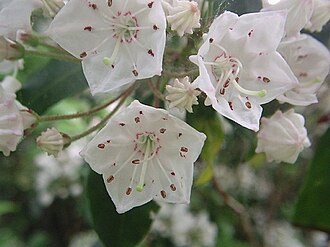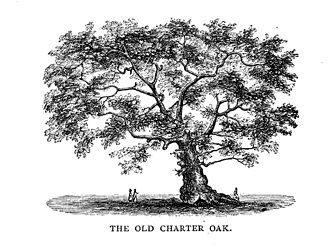Flora of Connecticut


Flora of Connecticut refers to the variety of plant species that are native to the state of Connecticut, located in the northeastern region of the United States. The state's diverse ecosystems, ranging from coastal marshes and beaches to forests and meadows, support a wide array of plant life. This article provides an overview of the significant plants found in Connecticut, highlighting their ecological roles and conservation status.
Overview[edit]
Connecticut's flora is characterized by a mix of northern and southern species due to its transitional location between the colder northern climates and the warmer southern areas. The state's vegetation is influenced by various factors, including soil type, elevation, and proximity to water bodies. Connecticut's forests are predominantly composed of deciduous trees, with coniferous trees and mixed woodlands also present.
Key Plant Species[edit]
Deciduous Trees[edit]
- Quercus rubra (Northern Red Oak) - The state tree of Connecticut, known for its adaptability and vibrant fall foliage.
- Acer saccharum (Sugar Maple) - A significant species for its sap, which is used to produce maple syrup, and its colorful autumn leaves.
- Betula papyrifera (Paper Birch) - Noted for its distinctive white bark and importance to wildlife.
Coniferous Trees[edit]
- Pinus strobus (Eastern White Pine) - Once heavily logged for shipbuilding and construction, it remains a vital part of the forest ecosystem.
- Tsuga canadensis (Eastern Hemlock) - Under threat from the invasive hemlock woolly adelgid, efforts are underway to protect this species.
Flowering Plants[edit]
- Lobelia cardinalis (Cardinal Flower) - A striking red flower that thrives in wetlands and along streambanks.
- Asclepias syriaca (Common Milkweed) - Essential for the monarch butterfly's lifecycle and recognized for its medicinal properties.
Invasive Species[edit]
Connecticut's flora is also impacted by invasive species, which can outcompete native plants and disrupt ecosystems. Notable invaders include:
- Alliaria petiolata (Garlic Mustard) - A herbaceous plant that dominates forest floors, hindering the growth of native species.
- Celastrus orbiculatus (Oriental Bittersweet) - A vine that can strangle trees and shrubs.
Conservation[edit]
Efforts to conserve Connecticut's native flora involve protecting habitats, controlling invasive species, and restoring damaged ecosystems. Organizations such as the Connecticut Department of Energy and Environmental Protection (DEEP) and various non-profit groups work towards these goals. Conservation is crucial for maintaining biodiversity, ecosystem services, and the natural beauty of the state.
See Also[edit]

This article is a environment-related stub. You can help WikiMD by expanding it!
Ad. Transform your life with W8MD's Budget GLP-1 injections from $75


W8MD offers a medical weight loss program to lose weight in Philadelphia. Our physician-supervised medical weight loss provides:
- Weight loss injections in NYC (generic and brand names):
- Zepbound / Mounjaro, Wegovy / Ozempic, Saxenda
- Most insurances accepted or discounted self-pay rates. We will obtain insurance prior authorizations if needed.
- Generic GLP1 weight loss injections from $75 for the starting dose.
- Also offer prescription weight loss medications including Phentermine, Qsymia, Diethylpropion, Contrave etc.
NYC weight loss doctor appointmentsNYC weight loss doctor appointments
Start your NYC weight loss journey today at our NYC medical weight loss and Philadelphia medical weight loss clinics.
- Call 718-946-5500 to lose weight in NYC or for medical weight loss in Philadelphia 215-676-2334.
- Tags:NYC medical weight loss, Philadelphia lose weight Zepbound NYC, Budget GLP1 weight loss injections, Wegovy Philadelphia, Wegovy NYC, Philadelphia medical weight loss, Brookly weight loss and Wegovy NYC
|
WikiMD's Wellness Encyclopedia |
| Let Food Be Thy Medicine Medicine Thy Food - Hippocrates |
Medical Disclaimer: WikiMD is not a substitute for professional medical advice. The information on WikiMD is provided as an information resource only, may be incorrect, outdated or misleading, and is not to be used or relied on for any diagnostic or treatment purposes. Please consult your health care provider before making any healthcare decisions or for guidance about a specific medical condition. WikiMD expressly disclaims responsibility, and shall have no liability, for any damages, loss, injury, or liability whatsoever suffered as a result of your reliance on the information contained in this site. By visiting this site you agree to the foregoing terms and conditions, which may from time to time be changed or supplemented by WikiMD. If you do not agree to the foregoing terms and conditions, you should not enter or use this site. See full disclaimer.
Credits:Most images are courtesy of Wikimedia commons, and templates, categories Wikipedia, licensed under CC BY SA or similar.
Translate this page: - East Asian
中文,
日本,
한국어,
South Asian
हिन्दी,
தமிழ்,
తెలుగు,
Urdu,
ಕನ್ನಡ,
Southeast Asian
Indonesian,
Vietnamese,
Thai,
မြန်မာဘာသာ,
বাংলা
European
español,
Deutsch,
français,
Greek,
português do Brasil,
polski,
română,
русский,
Nederlands,
norsk,
svenska,
suomi,
Italian
Middle Eastern & African
عربى,
Turkish,
Persian,
Hebrew,
Afrikaans,
isiZulu,
Kiswahili,
Other
Bulgarian,
Hungarian,
Czech,
Swedish,
മലയാളം,
मराठी,
ਪੰਜਾਬੀ,
ગુજરાતી,
Portuguese,
Ukrainian